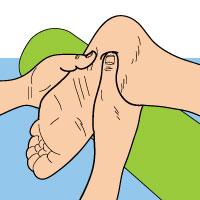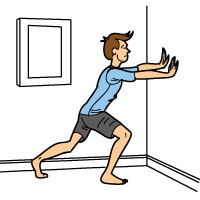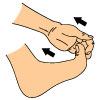Plantar Fasciitis Surgery
You do not want to undergo surgery in order to treat your Plantar Fasciitis. Surgery for Plantar Fasciitis involves the removal or “release” of a portion of the Plantar Fascia tissue, as this is what is thought to be causing the pain. You do not want part of your Plantar Fascia to be removed. This will loosen the Plantar Fascia, leading to the possibility of fallen arches. You can avoid surgery. It is not required in most cases. Plantar Fasciitis Surgery can actually result in complete rupture of the Plantar Fascia. There is also a possibility that the procedure won’t get rid of the pain and that your Plantar Fasciitis will persist.
 Painkillers
Painkillers
Painkillers have their appropriate time and place. This should be during times of rest. Do not take painkillers during times of physical activity, as they completely block the pain, keeping you from feeling any re-injury you may be doing to the Plantar Fascia. Painkillers are effective when used to relieve pain and swelling when you’re off you’re feet, such as when you’re sleeping. However, using them in order to stay active will only make your Plantar Fasciitis worse. Without having the pain there to stop you from overdoing it, you run the risk of pushing yourself too far physically, which can result in complete rupture of the Plantar Fascia.
 Massage
Massage
When you have Plantar Fasciitis, resting your foot is important. You want to try to avoid any pressure being applied to the bottom of your foot, where your Plantar Fascia is. Any pressure on your feet should be sustained by the heel and ball (Metatarsals). That’s why you want to avoid having your Plantar massaged. Your Plantar needs to be immobilized, not pressed down on. Your injured Plantar needs to be treated with care, just like any other injury. For example, if you broke a bone in your foot, you would use crutches to keep the weight off it, not use massage. It’s no different than treating an injured Plantar. While massage will stimulate blood flow, the risk of re-injury is too high.
Calf Stretches, Toe Stretches & Heel Raises
There are several stretches and exercises that can help treat Plantar Fasciitis, but these should be done later on in the healing process. Calf Stretches, Toe Stretches and Heel Raises, however, will only lead to re-injury.
 Calf Stretches – Calf Stretches are done by standing several feet in front of a wall and placing your arms out in front of you so your hands are resting flat on the wall. You would then position the leg on your injured side so it is straight behind you and step forward with your uninjured foot so the knee on your uninjured side is bent, then lean into the wall. While this stretch is not necessarily incorrect, it is often done far too soon in the healing process. Calf Stretches should only be attempted if you are nearly done healing the Plantar. If you do attempt a Calf Stretch, not matter how far along in the healing process you are, be very careful to not stretch the calf muscle too far. If the stretch is painful, don’t do it.
Calf Stretches – Calf Stretches are done by standing several feet in front of a wall and placing your arms out in front of you so your hands are resting flat on the wall. You would then position the leg on your injured side so it is straight behind you and step forward with your uninjured foot so the knee on your uninjured side is bent, then lean into the wall. While this stretch is not necessarily incorrect, it is often done far too soon in the healing process. Calf Stretches should only be attempted if you are nearly done healing the Plantar. If you do attempt a Calf Stretch, not matter how far along in the healing process you are, be very careful to not stretch the calf muscle too far. If the stretch is painful, don’t do it.
Toe Stretches – A Toe Stretch is done by pulling the toes of your injured foot up towards your shin with your hands. This stretch is unnatural and overstretches the Plantar. While it may feel good to do Toe Stretches, they cause tearing in the long run.
 Heel Raises – A Heel Raise is done by attempting to stand on the balls of your feet, with your heels raised. You do not want to do anything that puts all of your weight on the balls of your feet, as this will cause stress on the Plantar Fascia. You want some of your weight to be balanced on your heel and some on your Metatarsals. Balancing all of your weight on one area of your foot is a bad idea.
Heel Raises – A Heel Raise is done by attempting to stand on the balls of your feet, with your heels raised. You do not want to do anything that puts all of your weight on the balls of your feet, as this will cause stress on the Plantar Fascia. You want some of your weight to be balanced on your heel and some on your Metatarsals. Balancing all of your weight on one area of your foot is a bad idea.
